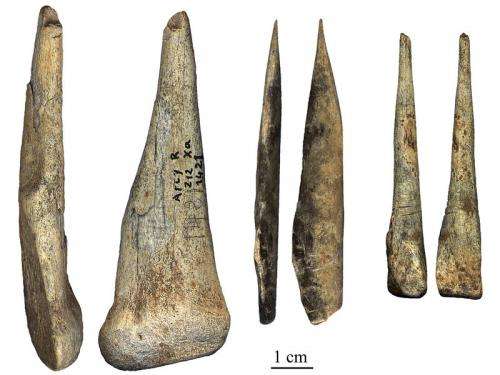September 19, 2016 report
New evidence suggests ancient jewelry at Grotte du Renne cave made by Neanderthals

(Phys.org)—A team with members from across Europe has found evidence that suggests bone fragments found with ancient jewelry in the Grotte du Renne cave at Arcy-sur-Cure (in France) show that they were made by Neanderthals. They have published a paper in Proceedings of the National Academy of Sciences outlining their work, their results, and what their finding may mean regarding the abilities of Neanderthals.
The Grotte de Renne was discovered in 1949 to be an archaeological treasure as archaeologists found bones and other artifacts that were subsequently dated to a time approximately 40,000 years ago—during the period when modern humans are believed to have been replacing the Neanderthals living in the area. Early evidence pointed to the Neanderthals as the makers of the artifacts, which included jewelry, but the consensus has been that Neanderthals did not possess the brain power to create such items; thus, some suggested there must have been a mix-up by the digging team. In this new analysis, the researchers took a closer look at some bone fragments from the site that were too small to be identified by conventional means. Because there was not enough DNA in the bones, the team chose to use a new method of identification: protein analysis. That allowed them to determine that the fragment was from a human, but more was needed to determine if it was modern human or Neanderthal.
To find that answer, the team conducted a chemical analysis of the protein in the sample and compared the results to both modern humans and other Neanderthal samples, which revealed that it was, indeed, from a Neanderthal. Additionally, they found chemicals in the sample that suggested that the bone fragment was from an infant that was still breastfeeding. These findings place the jewelry with the Neanderthal bones at roughly the same time and location, which the researchers suggest is strong evidence that the Neanderthal created them. The researchers do not, however, address the possibility that the Neanderthals simply took the jewelry from humans they had encountered or received them as gifts—a distinct possibility, as prior research has shown interbreeding occurred, which conceivably may have included gift-giving as a courtship ritual.
The study is reported in the paper "Palaeoproteomic evidence identifies archaic hominins associated with the Châtelperronian at the Grotte du Renne".
More information: Frido Welker et al. Palaeoproteomic evidence identifies archaic hominins associated with the Châtelperronian at the Grotte du Renne, Proceedings of the National Academy of Sciences (2016). DOI: 10.1073/pnas.1605834113
Abstract
In Western Europe, the Middle to Upper Paleolithic transition is associated with the disappearance of Neandertals and the spread of anatomically modern humans (AMHs). Current chronological, behavioral, and biological models of this transitional period hinge on the Châtelperronian technocomplex. At the site of the Grotte du Renne, Arcy-sur-Cure, morphological Neandertal specimens are not directly dated but are contextually associated with the Châtelperronian, which contains bone points and beads. The association between Neandertals and this "transitional" assemblage has been controversial because of the lack either of a direct hominin radiocarbon date or of molecular confirmation of the Neandertal affiliation. Here we provide further evidence for a Neandertal–Châtelperronian association at the Grotte du Renne through biomolecular and chronological analysis. We identified 28 additional hominin specimens through zooarchaeology by mass spectrometry (ZooMS) screening of morphologically uninformative bone specimens from Châtelperronian layers at the Grotte du Renne. Next, we obtain an ancient hominin bone proteome through liquid chromatography-MS/MS analysis and error-tolerant amino acid sequence analysis. Analysis of this palaeoproteome allows us to provide phylogenetic and physiological information on these ancient hominin specimens. We distinguish Late Pleistocene clades within the genus Homo based on ancient protein evidence through the identification of an archaic-derived amino acid sequence for the collagen type X, alpha-1 (COL10α1) protein. We support this by obtaining ancient mtDNA sequences, which indicate a Neandertal ancestry for these specimens. Direct accelerator mass spectometry radiocarbon dating and Bayesian modeling confirm that the hominin specimens date to the Châtelperronian at the Grotte du Renne.
Journal information: Proceedings of the National Academy of Sciences
© 2016 Phys.org





















